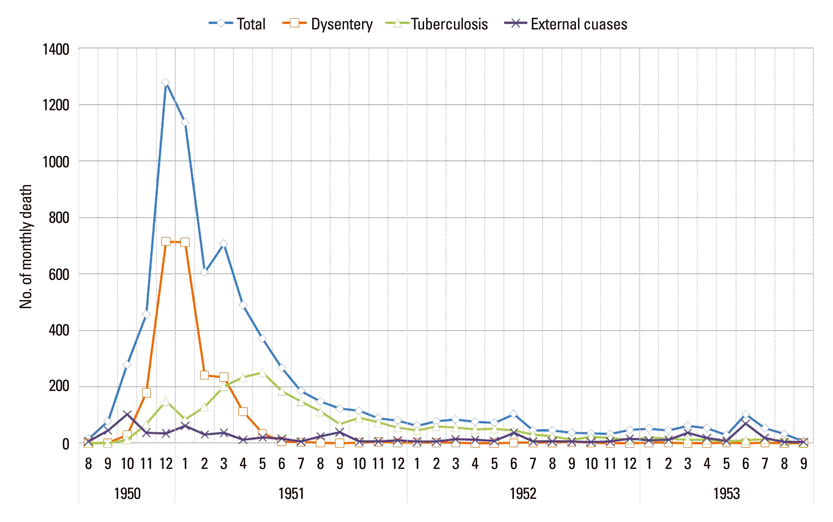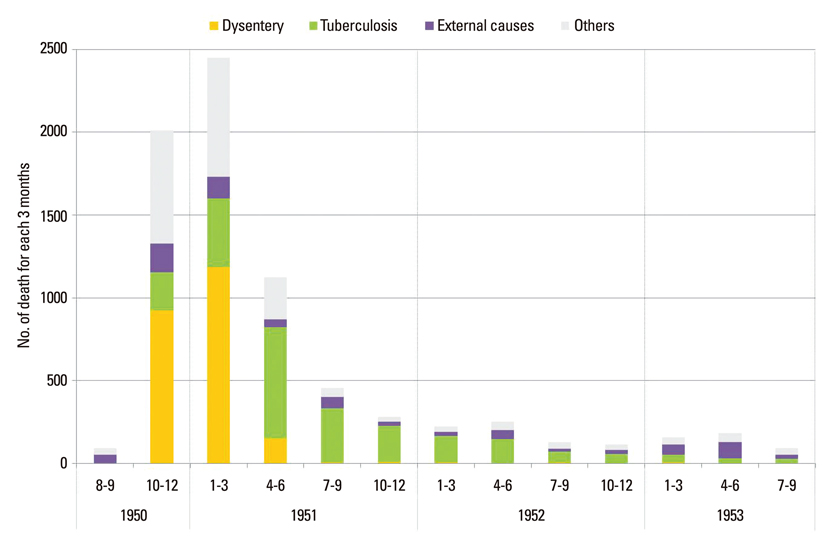Yonsei Med J.
2013 Mar;54(2):480-488. 10.3349/ymj.2013.54.2.480.
Causes of Death of Prisoners of War during the Korean War (1950-1953)
- Affiliations
-
- 1Department of Social and Preventive Medicine, Sungkyunkwan University School of Medicine, Suwon, Korea.
- 2Department of Parasitology and Institute of Medical Education, College of Medicine, Hallym University, Chuncheon, Korea. shuh@hallym.ac.kr
- KMID: 1503914
- DOI: http://doi.org/10.3349/ymj.2013.54.2.480
Abstract
- PURPOSE
This study aimed at analyzing the causes of death of prisoners of war (POWs) during the Korean War (1950-1953) who fought for the Communist side (North Korea and the People's Republic of China). In 1998, the United States Department of Defense released new information about the prisoners including, 7,614 deaths of the POW during the Korean War. The data on the causes of death of the POWs during the Korean War provides valuable information on the both the public health and history of the conflict.
MATERIALS AND METHODS
To analyze the causes of death of the POWs, we classified the clinical diagnosis and findings on 7,614 deaths into 22 chapters, as outlined in the International Statistical Classification of Diseases and Related Health Problems-10th Revision (ICD-10). Second, we traced changes in the monthly death totals of POWs as well as deaths caused by common infectious diseases and external causes of death including injury over time from August 1950 to September 1953.
RESULTS
The most common category of causes of deaths of POWs was infectious disease, 5,013 (65.8%) out of 7,614 deaths, followed by external causes including injury, 817 (10.7%). Overall, tuberculosis and dysentery/diarrhea were the most common causes of death. Deaths caused by acute and chronic infection, or external causes showed different patterns of increases and decline over time during the Korean War.
CONCLUSION
The information and data on POWs' deaths during the Korean War reflects the critical impact of the POWs' living conditions and the effect of public health measures implemented in POW camps during the war.
MeSH Terms
Figure
Reference
-
1. Cho SH. Korean War and Prisoners of War. 2010. Seoul: Seonin;3384119–130.2. Lee S. The United States, the United Nations and the second occupation of Korea, 1950-1951. The Asia-Pacific Journal: Japan Focus [Internet]. 2011. cited 2012 March 15. [about 9p.]. Available at: http://japanfocus.org/-Steven-Lee/3457.3. Leedham CL. Heaton LD, Stone WS, editors. Tuberculosis. Medical science publication No. 4, volume II.: based on professional medical experiences in Japan and Korea. Proceedings of the Recent Advances Medical and Surgery. 1954 April 19-30; Washington D.C: US Army Medical Service Graduate School, Walter Reed Army Medical Center.4. G-5, Headquarters, Far East Command, United Nations Command. United Nations civil affairs activities in Korea. Monthly Summary. 1952. Washington D.C.: United Nations Command;United States National Archives and Records Administration RG407 Box 1359 Book XII.5. United Nations Command. Civil assistance and economic affairs, Korea. 1954. Washington D.C.: United Nations Command.6. Yoon HC. Preventive medicine in a Korean division. Med Bull US. 1953. 1:190–191.7. Pruitt FW. Heaton LD, Stone WS. General aspects of medicine in Korea and Japan 1950-53. Medical science publication No. 4, volume II.: based on professional medical experiences in Japan and Korea. Proceedings of the Recent Advances Medical and Surgery. 1954 April 19-30; Washington D.C: US Army Medical Service Graduate School, Walter Reed Army Medical Center.8. Millett AR. War behind the wire: Koje-do prison camp. MHQ: the Quarterly Journal of Military History [Internet]. 2009. 01. 20. cited 2012 March 15. [3p.]. Available at: http://www. istorynet.com/war-behind-the-wire-koje-do-prison-camp.htm.9. Cole RH. A survey of united states detainee doctrine and experience since World War II. 2006. Carlisle, UK: U.S. Army War College.10. Karpen RJ. Preventive medicine activities in the Far East. Med Bull US. 1953. 1:104.11. Lee S. The United Nations civil assistance command and Koreans in wartime southern Korea, 1951-1952. Paper presented at: a Workshop on North and South Korea in the 1950s. 2011 December 10; Vancouver, Canada: University of Columbia.12. Garfinkel ET. Heaton LD, Stone WS, editors. Enteric diseases among Korean and Chinese prisoners of war. Medical science publication No. 4, volume II.: based on professional medical experiences in Japan and Korea. Proceedings of the Recent Advances Medical and Surgery. 1954 April 19-30; Washington D.C.: US Army Medical Service Graduate School, Walter Reed Army Medical Center.13. Kim SL. Dysentery in Korea. Med Bull US. 1953. 1:191–193.
- Full Text Links
- Actions
-
Cited
- CITED
-
- Close
- Share
- Similar articles
-
- Parasitic Diseases as the Cause of Death of Prisoners of War during the Korean War (1950-1953)
- Psychiatric Casualties during the Korean War: Focusing on American and Common Wealth Soldiers
- A Foundation for a “Cheerful Society”: The Korean War and the Rise of Psychiatry
- Pathology in Korea during the Period 1945~1957
- DDT Resistance Korean Body Lice and Development of Insecticide Resistance Knowledge during Korean War



